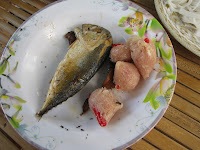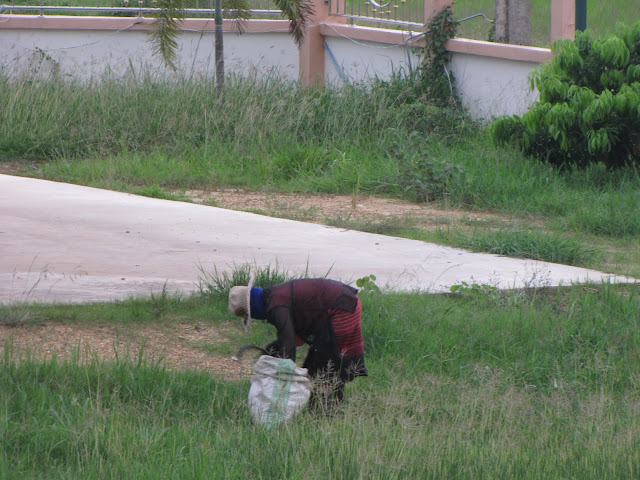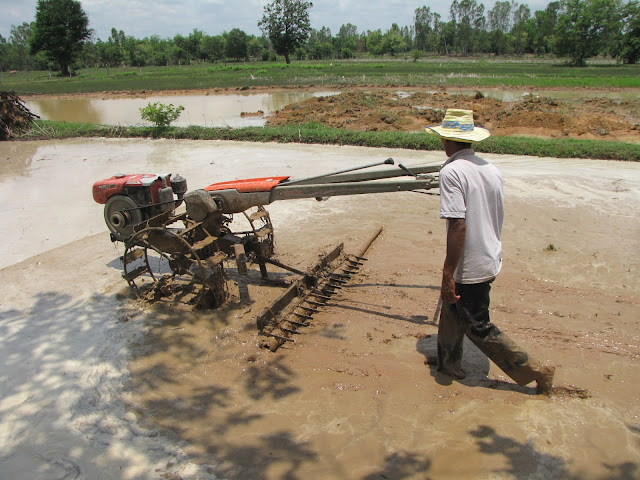We moved to Isaan on November 5, 2012. Between then and when we left for vacation on April 8, 2013, we saw only about 3 or 4 rainfalls, most notably the downpour in the middle of the Loi Krathong festival (see blog posting of November 28). It got very hang lang (dry) around here as you can see from the photo below of the rice fields across the street from our apartment building.
We heard the rainy season would likely start around mid-May and then we could expect rain most every day.
Before we left for vacation and while we traveled on vacation, we noticed a tree blooming with spectacular reddish-orange blossoms. We learned that the Thais call it a "peacock tree." Although reddish-orange isn't the color we associate with peacocks, the tree surely is as showy as a peacock.
During April, we didn't see any rain in Chiang Dao in the north of Thailand and very little in Koh Chang in the southeast, but there must have been a lot of rain in Khemmarat while we were gone. Here's what those same rice fields looked like when we got back.
Now that we've been back for awhile, we've seen what the rainy season looks like. During the "summer," the sky was almost perfectly clear and the sun hot and intense all day. Since we've been back, there are a lot more clouds in the sky (giving some relief from the intense sun), and periodically the clouds seem to gather and get darker and then there is a heavy downpour. Here are some pictures off the balcony of our apartment and out our window.
We found this comment on the rainy season in Isaan on an expat web site: "All day rains are rare. It's rained probably 9 out of the last 10 days but not for very long at a time. Just enough to make it ridiculously humid, bring out all the creepy crawly critters and make everything lush and green."
That is a good summary of our experience -- some heavy rain most days but not lasting long, cooler but more humid afterward, lots of bugs, and the "jungle" has been coming back to life. Flowers are getting a second wind.
And the flowers seem to be bringing butterflies. They fly along the river like an Easter Parade -- a steady flow from south to north (it seems). Many are simple white butterflies, but the peacock trees attract these beauties.
As the fields flooded, we noticed some new activity. Some folks were out with plastic bags catching frogs for dinner.
Other folks were cutting the new-grown grass -- to feed to their cows, we understand.
We have lived with geckos since we arrived in Khemmarat last November, but the rainy season seems to have brought out larger lizards. Fortunately, we haven't seen any of them in our apartments yet, but they do hang out on the balcony. They don't seem to be as shy as the geckos, but they can be very quick. Here's one of them.
The Start of the Rice Season
Rice is the mainstay of the Thai diet and economy and is served with salads, meats, poultry, fish, and sea food. Rice production represents a significant portion of the Thai economy and labor force. Thais produce enough not only to feed themselves, but also to be one of the world's largest rice exporters.
Besides its economic importance, rice has a deep psychological and cultural meaning for the Thai, according to Phraya Anuman Rajadhon (1888-1969), distinguished Thai historian and scholar of the customs and traditions of his country. When a Thai wishes to say he is hungry, he says, "Hiu khao" or "I'm hungry for rice." When he is eating, he says, "Tan khao" or "I'm eating rice." Even when he refers to food in general he uses the word khao, meaning rice. We have been invited by Thais to "Gin khao," by which they mean to sit with them and eat.
There are many rituals and ceremonies that accompany rice farming. We understand that these observances are founded on the belief that there is a Rice Goddess or Rice Mother, Mae Pho Sop, who, if properly worshiped and propitiated, will reward the farmer with prosperity and good health. Pho Sop is part of very ancient Thai folklore, rather than of the mainstream Buddhist religion. Belief in ghosts in Thai culture is both popular and enduring. In the history of Thailand, Buddhist popular beliefs intermingled with the legends about ghosts of the local folklore.
At the beginning of the rice planting season, there is a ceremony in Bangkok that involves the lord of the Royal Plowing Ceremony throwing rice seeds as he walks around the Grand Palace, as the Crown Prince of Thailand watches.
There are also many local ceremonies. George's Thai friend Tom (see March 15 and 16 blog posts) called and said he would pick George up on Friday, May 10. Because of the language difficulty, George didn't try to figure out what was planned for the visit. (The rest of this story is George's, so it will be in the first person.)
On that Friday morning, there was a ceremony taking place in the park a block from our apartment. As we motor biked past, Tom pointed it out excitedly. When we arrived in Baan Non Tum, I said hello to the family and friends gathered and we walked to a nearby shrine. We accompanied Oanchittha, a neighbor of Tom's and a 5th grade teacher whom I had met on an earlier visit. She was carrying an offering. I was told that offerings were made to a "ghost" for a good rice crop.
A large crowd had gathered and brought many offerings.
Folks brought their offerings to the shrine.
Here are the figures on the shrine. I don't know about the figure on top, but I believe that is the Rice Goddess on the left in the first picture and that looks like a "ghost" in the second picture.
Then Tom told me it was time to go. We walked back to his home and got on the motorbike to head to his rice fields. Here is Tom holding rice seed that he would be planting.
And then he started plowing. The tractor is pulling a kind of rake that breaks up the clumps of mud.
Tom enjoys his work,
and likes to entertain his friends -- here he chases the tractor he had let run free.
Here's what the field looks like when Tom finishes breaking up the mud.
While Tom plowed, his brother-in-law Yot did some net fishing in an adjoining rice paddy. (I don't think he caught any that day.)
Next Tom tied a log to his plow so that it would flatten the mud rather than break it up.
Next, we scattered the seed. Tom insisted I go first but his Uncle Som kept an eye on me.
Som showed me how 30-day-old seedlings are transplanted into the mud. We read about farmers starting the rice as seedlings and then putting it into the paddies after 30 days and Tom seemed to be agreeing that he would do that (that damn language barrier!), but it's hard for me to believe -- look below at all the seed he's throwing out (all those little splashes in the water)! But I'll be back to see what he does in 30 days and will report what I see.
Back to Tom's home for lunch. His wife Runee had dressed for the festival at the shrine so I took the opportunity to try to capture her beauty.


Back to seed another field, but now a storm was coming up.
We retreated to a shelter on Tom's property. We had brought some of the children with us and they had fun while we waited out the storm.
As the storm passed, a rainbow appeared just above the trees.
I was hoping Tom would teach me about the rice production process. I'm not sure we'll be here long enough to see the harvest, but he gave me a great hands-on lesson in the planting step. Thanks, Tom!
The night after my trip with Tom, storms arrived in Khemmarat in the wee hours: thunder boomed and heavy rain poured down. By dawn, it had settled into just heavy rain until about 11 am. There was a lot of rain! I hope that was good for the rice. Here's what the fields across the street (pictured at the top of this post) looked like in the morning.
And the rains have brought new sounds -- very loud croaking frogs. Mary (our rising videographer) recorded them in this video, taken from our balcony, and one of our gecko friends joined in the serenade:
We are amazed at the stark difference between the dry season and the rainy season in Thailand!























.JPG)





.JPG)





















No comments:
Post a Comment